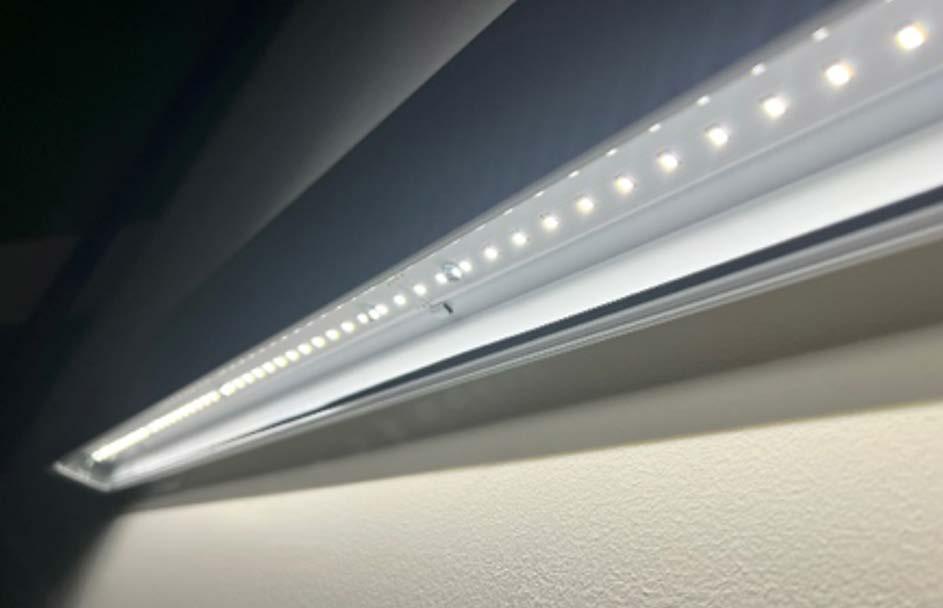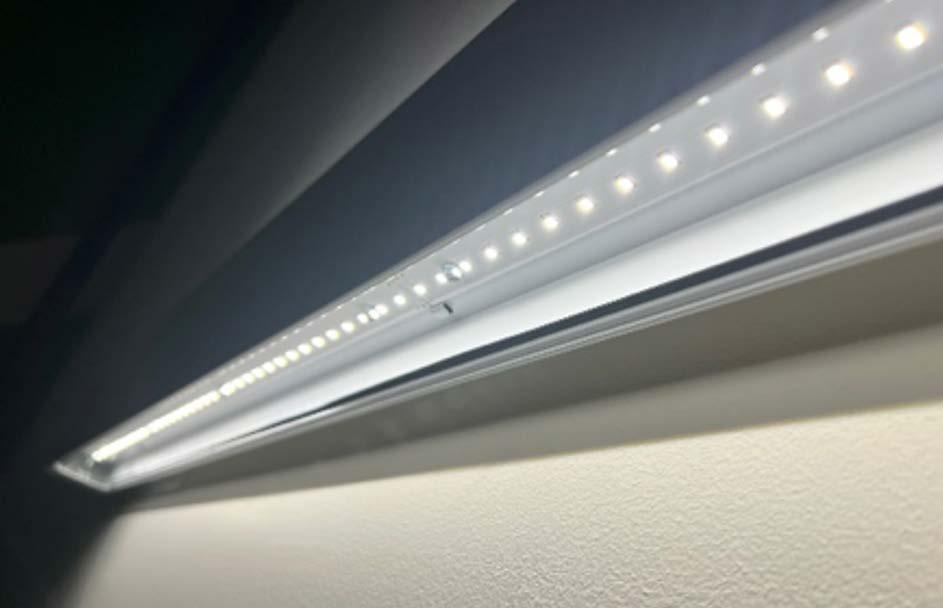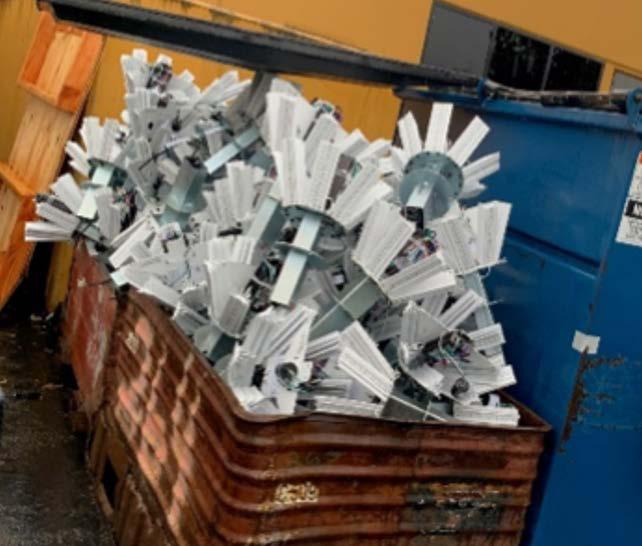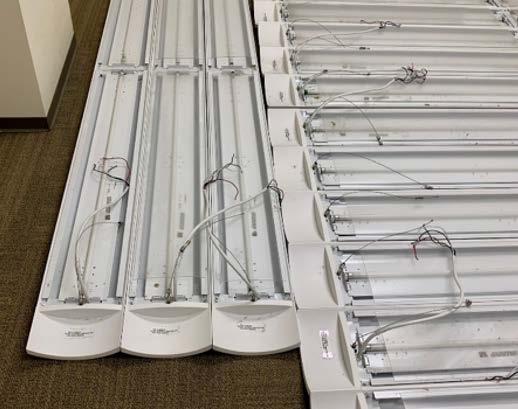
7 minute read
Extending the Life of Your Design
from FEB/MAR 2023
The Role of the Agent in the Circular Economy of Lighting
By Jonathan Schwenke, LC, Form Lighting and Controls
My start in lighting was on the specification side, working for an MEP firm in Seattle, WA. The first LED luminaire I can recall being installed was for the City of Seattle in 2009, replacing 6” downlights in several restrooms managed by the city. The first few questions I remember hearing revolved around how they would maintain these new high-tech luminaires. The answer was simple…“That’s so far off in the future, you won’t even need to worry about it.” Well, here we are in the future. I am now playing an important role supporting the efforts of building maintenance professionals on what to do next. Agencies across the country are routinely hunting down warranty information, diagnosing issues, coming up with LED-to-LED replacement solutions, suggesting sustainable methods of recycling, and list goes on.

Engineered custom kit being fit tested in an 8’ four lamp T5HO direct/indirect wall mounted luminaire (shown with opaque lens removed).
Credit: Jonathan Schwenke
I’m thrilled that the idea of a circular economy is gaining traction in lighting. Lighting agencies are in the trenches, aiding in the decision to re-lamp, retrofit or replace fixtures in existing buildings. Holistically, agencies will help specifiers evaluate vintages, light quality, potential energy savings, control methodology and future maintenance requirements. Agencies will also get the dreaded call from building maintenance professionals stating that they can’t find replacement parts, or their control system no longer works despite having been installed just a few years ago. We handle these scenarios similarly, except for the fact that one requires an immediate affordable solution and the other (holistic approach) gives us time to do some real investigating, typically with a larger budget at our disposal. Both, however, should not involve scrapping the initial design for the sake of selling more luminaires. Agencies want to satisfy customers, but the task is daunting at times given the variety of LED luminaires installed today. I’m hoping this article will help by starting the conversation, earlier in the process, of what to expect once a project is turned over.
Manufacturer Warranties
Operating & maintenance manuals (O&Ms) are critical and can typically be found on site, but, in some cases, they’re missing important information. Most lighting manufacturers rely on the electrical distributor’s purchase order number to determine warranty status. With some lighting manufacturers giving a 10-year warranty, the O&M manual or network folder could be long gone. A better solution is to specify that the distributor’s PO number is added to the label on the fixture itself. Most manufacturers can include a printed label during manufacture at little to no added cost. One might ask why the project name or building address would not suffice to identify a product’s origin? The reasons are plenty: the product was purchased on a stock order, was part of a national account purchase, NDAs required building name to be generic, the address given was a staging area, etcetera.
Without good information, warranties can take weeks to figure out. What usually happens is that your customer pays for a new fixture to replace one that’s still under warranty, plus attic stock if they didn’t order any in the first place. It’s worth noting that electrical distributors might not make project records accessible for as long as the fixture is warranted, so relying on distribution to find order information may lead you to a dead end.
Agencies are responsible for vetting their manufacturers. Working with a lighting agency should give you peace of mind that the manufacturers they partner with are credible and stand by their product and warranty terms. The size of a manufacturer is not necessarily a good measuring stick for their product reliability or customer service. I tend to lean on their engineering team’s knowledge of their product, the simplicity of their warranty program and the manufacturer’s ESG factors (Environmental, Social and Governance).

Unknown LED kits removed early due to poor performance.
Credit: Jonathan Schwenke
Light Quality and Controls
Simple lamp equivalent or “like for like” solutions economically make sense but are recommended only after a lengthy discussion on code requirements and control options. Light level requirements or the demands of the space may have changed since the initial installation. Agencies will aid in the research of local ordinances, IES Recommended Practices, Department of Health requirements and others to make sure the performance of the lighting system is up to date.
Local codes will also dictate required control methods, but, in most cases, adding dimming capabilities to a newly retrofitted space will aid in appeasing the demands of those who occupy these spaces and reduce the number of complaints after installation. It’s never as simple as “like for like.”
When dismantling an existing control system, we tend to push customers towards systems that can be expanded over time and offer control protocols that are prevalent in all types of building products and not specific to just lighting. These protocols can be wired or wireless systems. For instance, if issues arise in the common areas of the building and we’ve confirmed the existing control system is antiquated or no longer supported, we’ll disconnect those specific lighting circuits from the existing system and pull them into a new platform – typically a distributed system. This allows the building owner to use up the remaining useful life in the existing system and spread the cost of the upgrade over multiple annual budget cycles.
Key aspects of a new lighting control system include:
◆ Zero annual maintenance fees
◆ Self-hosted or stand-alone networks
◆ Manufacturer agnostic
◆ Easily expandable
◆ Secure and automatic
◆ Schedule-based control options
Having both occupancy/local and scheduled control gives the customer flexibility versus being stuck with a system that only does one or the other. If utility incentives are available for luminaire level lighting controls (LLLC) or networked lighting controls (NLC), we’ll push for upgrading the entire system to take advantage of these incentives.
Cost of Custom Kits
Converting the body of a fixture for which your customer paid around $120 per linear foot with a custom LED kit with dimming integration, creating what will be the equivalent of a new LED fixture, is not as involved as one might think. Continuing with the linear fixture example (pictured), an LED kit is roughly 30% the cost of a new fixture, and LED lamps with a dimming driver are roughly 20% the cost of a new fixture. Custom-engineered kits also increase our lumen output ceiling and light distribution options compared to an LED lamp and driver solution. This is relevant for existing fixtures using T5HO fluorescent or non-linear products using HID (high intensity discharge) lamps. A custom-designed kit also ensures that the fixture can be maintained for years to come with appropriate luminaire disconnects and, in some cases, tool-less fasteners. When taking this path with a customer, it’s good to check your local code requirements and confirm if a custom kit needs to have specific listings (ETL, UL, etc.). A custom kit manufacturer can provide the appropriate listing if requested.

Light fixtures with T5HO lamps removed from a building but saved due to the creation of a custom kit with appropriate lumen output, saving money while reducing waste. Luminaires were re-positioned to align with revised desk spacing.
Credit: Jonathan Schwenke
During the past decade, LED lighting has allowed the lighting design community to create amazing and environmentally conscious spaces. Lighting agencies are here to ensure that these designs present themselves as they were intended on day one. In the event you want to change things up, we’re also here to guide you through that process with a sustainable approach. And, who knows what tools we’ll have at our disposal when that time comes, but we’ll be ready. ■










